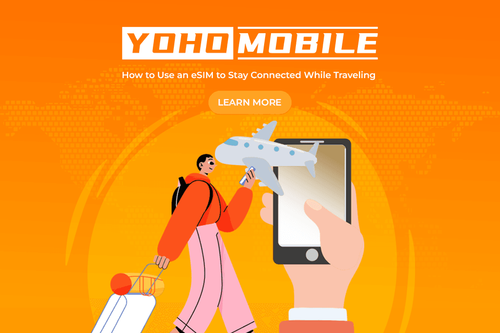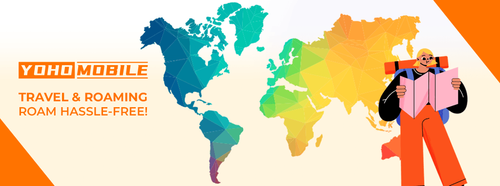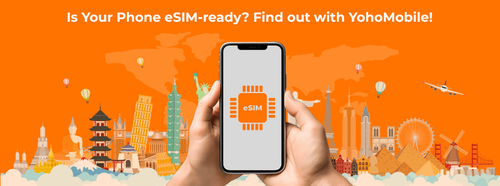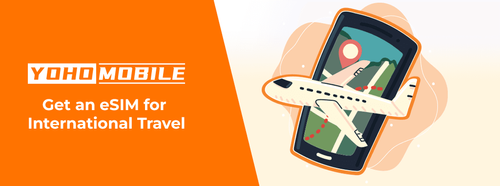Heading to Spain or Japan? Want to stay connected without those hefty roaming charges from your carrier? An eSIM data plan could be the perfect solution, but… eSIMs? You’ve only heard of them but haven’t used them yet. Maybe you haven’t traveled internationally much before, or the eSIM concept is just new to you. You’re hoping to find someone with experience using eSIM while traveling abroad who can help answer your questions. You’re in luck because you just found that someone! This guide will explain key aspects you need to know about an eSIM during international travel.

Image by Vecteezy
Related: 10+ Best Travel Apps For Every Traveler
eSIM Tech: The Basics
New to the world of eSIMs? An eSIM is like a built-in, invisible SIM card that lets your phone connect to the internet but there isn’t a tiny plastic card. Think of it as an upgrade that simplifies things – no more fumbling with trays or keeping track of a separate card. What’s more, eSIM providers have made it easy to use, so you can enjoy all the benefits without needing a tech degree.
Related: eSIM vs SIM Cards: Which One Fits Your Lifestyle?
All You Need Is…An eSIM
Remember the timeless wisdom of The Beatles’ “All You Need Is Love”? Well, in today’s digital age, you might need to add a little gadget to the mix: “All You Need Is…an eSIM.” Yes, you heard it right! The evolution of technology has drastically changed how we connect and travel and the eSIM is leading the charge.

Image by Vecteezy
But before you dive headfirst into this digital revolution, there are a few key aspects to consider:
1. Select a compatible device
Most recent iPhones, Google Pixel, Galaxys, and some Huawei, and OnePlus phones are eSIM-ready. But it’s always best to double-check with your phone’s brand or carrier to be sure. Here’s a useful list to verify it quickly.
2. Decide on an eSIM to travel internationally
Like a regular SIM card, but it’s digital. However, how to choose the right one? Let’s find out in a sec.
3. Ensure a stable Internet connection
You’ll need either Wi-Fi or any other internet source to activate the eSIM for the first time.
4. Install the eSIM
Once you have everything, installing the eSIM is easier than you might think! Just follow the provider’s instructions for your phone.
Is Your Phone eSIM-ready?
Are you considering a switch to eSIM? This chip in most newer phones allows you to ditch the traditional SIM card for a more streamlined experience.

Great news for iPhone users as most models (except some mainland China, Macao and Hong Kong versions) are eSIM compatible.
As for some Android users, it depends on your phone’s origin and model. Samsung Galaxy S20 FE, Note 20 Ultra, and Z Fold 2 from Hong Kong and the US might miss out on eSIM. But there’s good news for Samsung S21 users in Canada and USA (excluding FE models) as a software update might unlock the eSIM feature for your device.
Google Pixel fans with recent models (except for Pixel 3 devices from Australia, Japan, and Taiwan and Google Pixel 3a from Southeast Asia) are also in luck.
Before you take the leap, search your phone’s model and origin to clear things up! If your phone isn’t on this list, you’ll probably need a regular SIM card.
Is Your Phone Truly Free?
No, we’re not talking about freedom in the traditional sense. Instead, we are referring to two crucial aspects: whether your phone is “locked” to a specific carrier and if it can use eSIM for traveling internationally. How can you “liberate” your phone from carrier restrictions and harness the power of eSIM tech?
Are you eager to use an eSIM to travel internationally but worried about needing a new phone? Checking your phone’s compatibility couldn’t be easier, it is conveniently tucked away within your phone’s settings. To see if it’s free to switch carriers, navigate to the Network section, and for eSIM compatibility check the IMEI number.
Is it too complicated? We have a step-by-step guide for iPhone and Android users.
How Many eSIMs Can You Install on A Device?
While some devices can hoard a whopping 20, it’s more convenient to keep it around 3. Think of it like packing for a trip. You only use what you need at that moment, and with eSIMs, only one can be active at a time. So choose the eSIM that best fits your current needs, and swap them out as needed. It’s like having multiple phone plans on one device!
7 Tips to Choose the Right eSIM for International Travel
Traveling with an eSIM sounds easy, and sure it can be! But before you jump in, make sure you get the best experience. We’ve done the research and here are some key aspects to consider when choosing an eSIM provider for your trip.
1. Coverage
Make sure the chosen eSIM provider offers strong coverage in the places you’ll be visiting. Check their maps and ask about roaming charges or limitations. Strong coverage is crucial for a functional eSIM. Look for providers that partner with reputable carriers in your travel regions. This ensures automatic connection to the strongest network for seamless service.
You can always opt for a global eSIM to connect to mobile networks worldwide without switching physical SIMs. It provides seamless connectivity across countries, offering local rates for data, calls, and texts, thus avoiding expensive roaming charges.
2. Cost
Don’t just chase the cheapest deal. Look for providers offering competitive rates but also consider data limits, additional features (roaming, tethering), and plan options.
Read reviews on reliable platforms like Reddit or Trustpilot to ensure you’re getting the best value.
3. Data needs
When weighing data plans offered by an eSIM provider, consider factors like data speed, data caps, and any restrictions on hotspots to choose a plan that meets your needs.
4. Flexibility
Opt for providers with flexible plans and short contracts (if necessary). This allows you to switch providers or adjust your plan if your data needs change during your travels.
5. Customer support
Research the provider’s customer support reputation. Look for online reviews to gauge their responsiveness and ability to help with inquiries or issues. 24/7 support, preferably via direct chat or WhatsApp, is ideal for overseas assistance.
6. Security
Choose a provider with robust security measures like encryption and two-factor authentication to safeguard your personal and financial data.
7. User reviews
Read reviews and testimonials from other users to get a sense of the overall satisfaction with the eSIM provider. Look for feedback on reliability, network quality, and customer service. Trustpilot is a good resource for user reviews.
How to Get an eSIM for International Travel?
Many eSIM providers offer plans specifically designed for international travel. These plans provide internet access in +190 countries and regions and keep you connected on the go. With so many diverse options, you can choose a plan that best suits your travel needs.
In general, traveling with an eSIM data plan offers a practical solution. By using it as your secondary line, you can maintain two active eSIM plans on your phone. This allows you to keep the functionalities of your primary line, such as calls and texts while using the eSIM for internet access. Imagine using your home number for calls while traveling, and a separate eSIM data plan for browsing and navigation – all on the same phone!
Finally, how to get an eSIM for international travel? For iPhone users, it is as easy as visiting the App Store. Here’s a glance at the best eSIM apps available from various providers.
You May Also Like: The Best Travel Gadgets For Your Next Trip
How To Install a Travel eSIM?
1. Before you travel, prepare the eSIM
Ensure you have the QR code readily available, either displayed on another device or printed out. You’ll also need a stable internet connection during the setup process (for some eSIMs).
2. Install your eSIM
Ideally, install the eSIM a day before your trip. Choose to do it through a QR Code or the manual option provided by your carrier. You can then activate it during your flight or upon arrival at your destination.
3. Follow the device instructions
The installation process may vary slightly depending on your phone’s brand (iPhone, Samsung, Google Pixel). Follow the on-screen prompts specific to your device.
4. Need Help?
If you have trouble installing, read our Troubleshooting Guide.
For our Yoho Mobile users, feel free to contact us if you need help.

